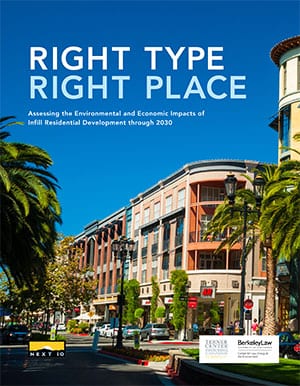March 2017
 Building the right kind of housing in the right places can help California meet its 2030 climate goals while growing the economy.
Building the right kind of housing in the right places can help California meet its 2030 climate goals while growing the economy.The study models three different scenarios for California’s housing future through 2030: business as usual, where development follows the same patterns it did from 2000 to 2015; a “medium” infill scenario, featuring much more infill housing and more multifamily housing; and an infill “target” scenario where all new housing development happens in infill areas, which also features more multifamily housing than the business-as-usual scenario.
Key Findings
While the business-as-usual scenario results in more car-dependent housing farther away from jobs and schools, the infill target scenario meets the same demand, spurring economic growth with a much smaller carbon footprint. Target scenario benefits include:
- Annual economic growth that’s over $800 million higher than business-as-usual.
- Annual reductions of 1.79 million metric tons of greenhouse gas emissions compared to the business-as-usual scenario, which is the equivalent of taking 378,000 cars off the road and almost 15 percent of the emissions reductions needed to reach the state’s Senate Bill 375 (Steinberg, 2008) targets from statewide land use changes.
- Lower overall monthly costs for average households.
Policy Recommendations
The target infill scenario isn’t possible without policy change, at both state and local levels. As California lawmakers consider over 130 bills written to address the state’s housing crisis, the report provides several recommendations for policymakers to consider, such as reducing barriers and increasing incentives for regions that generate infill housing, creating anti-displacement policies to protect affordable housing, and directing more funds towards public transit and affordable housing.
Download the Report:
See Our Op-Ed in Capitol Weekly
‘Infill development’ can help solve California’s housing crisis (Mar 28, 2017)
For More Information:
Contact Ethan Elkind, Director of the Climate Program at the Center for Law, Energy & the Environment